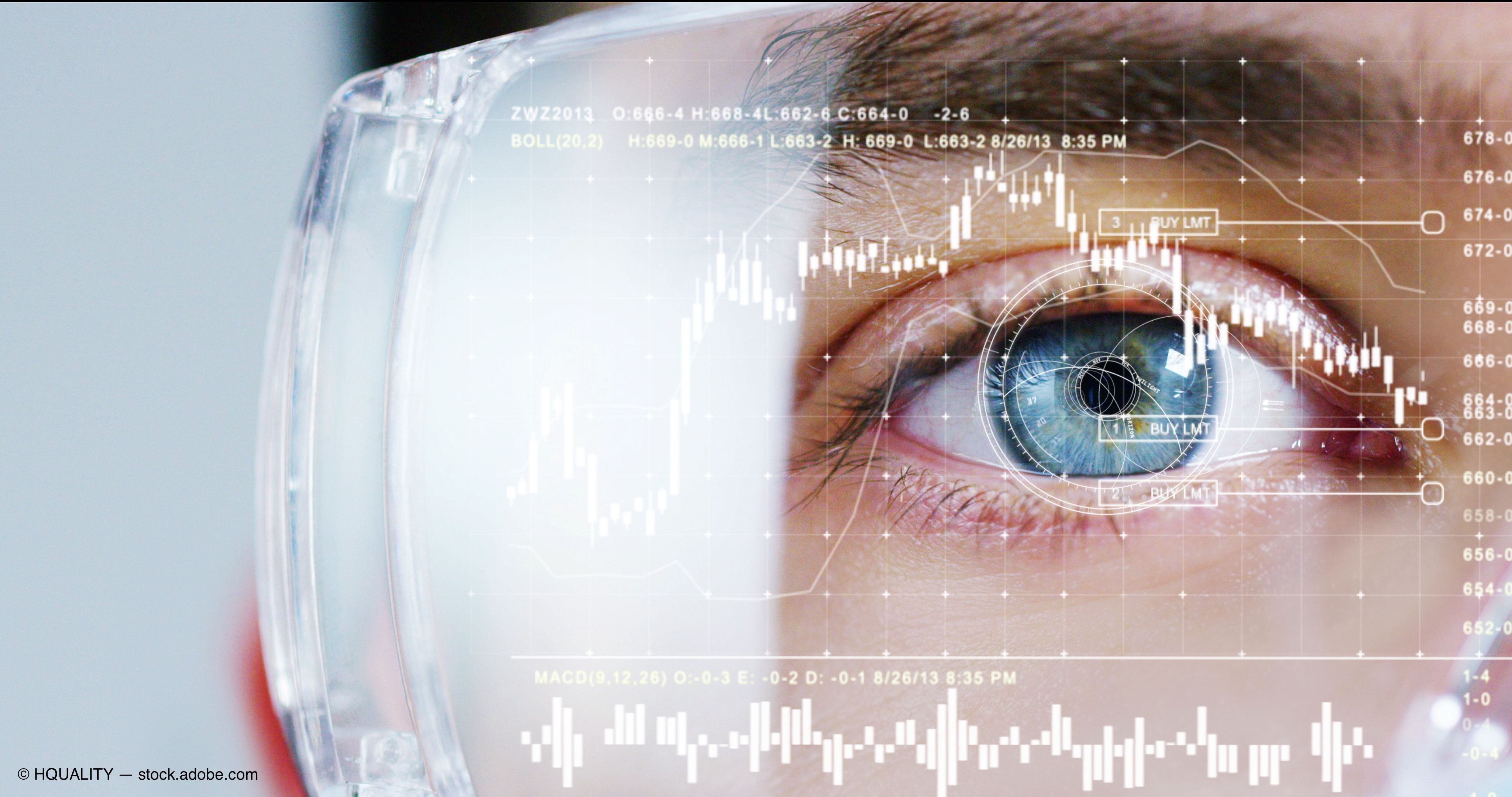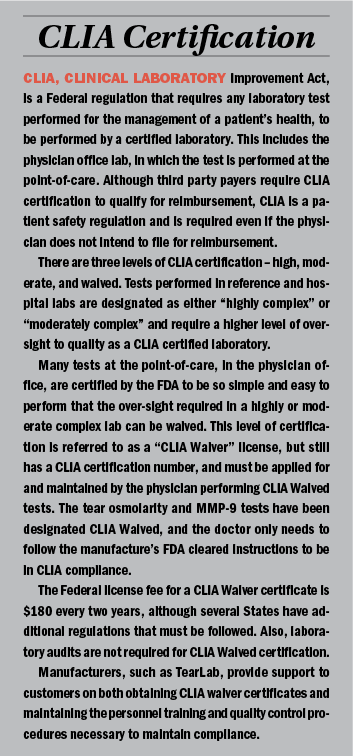Article
Lab tear tests aid reimbursements, clinical application of dry eye
Author(s):

Renewed interest in disease driving research, increasing understanding
When a physician seeks to determine a diagnosis and subsequent course of action for a patient, the clinical value of every step in that process is first and foremost. To drive that decision-making process, doctors have relied on laboratory tests about 70% of the time.1 In every specialty except eye care, that is.
This is no longer the case and eye care specialists are increasingly incorporating point of care in vitro diagnostic, or laboratory testing to aid in their management of patients’ ocular surface health.
Renewed interest in dry eye disease has spurred volumes of research and now a greater understanding of the fundamental role of the corneal surface in refractive, cataract and yes, even glaucoma, outcomes.
Related: Rethinking clinical strategy for treating dry eye disease
Eye care specialists also now have algorithms to help guide their use of emerging diagnostic tests and treatment modalities in light of the most up-to-date science and clinical evidence.
Several of these algorithms have identified the measurement of laboratory tests, tear osmolarity and matrix metalloproteinases 9 (MMP-9), as key markers of ocular surface health, and have subsequently provided detailed data, discussion and guidance around implementation. For example, the Cornea Clinical Committee of ASCRS2 has organized these tests.
In the real world, however, the clinical value of a diagnostic test must also be weighed against other practice considerations such as the resources required for its implementation, which are different for laboratory tests versus the standard diagnostics historically utilized by the eye care practitioner.
Related: Surfing the dry eye pipeline
Determining reimbursement
When it comes to insurance reimbursement, a test like TearLab’s osmolarity test is covered according to laboratory rules even though the test sample is not physically sent to an outside lab for analysis. Instead, eye care practitioners perform the test themselves as a CLIA-certified laboratory.
Therefore, third-party payers cover and reimburse these tests under the laboratory fee schedule, which for Medicare is the CMS Clinical Laboratory Fee Schedule3 and for the commercial carriers is found in the provider contract for each specific payer and may vary by provider.
Related: How payer perspective guides reimbursement
Billing rules and documentation for a lab test are different than what eye care physicians and their staff may be accustomed, requiring additional training, including the clinical staff for proper charting and the billing staff to ensure proper coding and processing.
The tear osmolarity test is universally covered in all 50 states by CMS Medicare, with the caveat that in Florida, there is a local coverage determination which provides an algorithm for testing.
If there are no local or national coverage determinations dictating the use of a test, it diverts to medical necessity rules. These rules are based on the physician’s medical opinion, supported by clinical guidelines, such as the ASCRS Cornea Clinical Committee algorithm,2 TFOS DEWS II Report4 and others.
Finally, for CMS Medicare Part B, there is no patient co-pay or deductible, so 100% of the fee is paid to the provider, with no financial impact on the patient.
Related: Reimbursement remains a hurdle for teleglaucoma in United States
Test documentation
When a practitioner uses his or her medical opinion along with the established guidelines to determine when to perform a tear osmolarity test, the decision must be properly documented in the patient’s chart. Because the documentation for laboratory testing differs from routine procedures and services, extra care should be taken to ensure four simple items are always included:

> A sign or symptom of disease must be present and identified during the patient’s current visit, or if the patient is being managed from a prior diagnosis, the condition must be unstable.
> The test must be ordered and although the order may be verbal, that order must be indicated in the chart.
> The test result - and if those results are normal or abnormal - must be noted.
> The test results must appear in the patient management plan at the end of the visit, even if the test is normal. In laboratory parlance, normal tests are considered “rule-out” tests, and if they were ordered due to a symptom indicating the possibility of a disease, the normal test ruling out that disease is fully reimbursable.
Related: The utility of normal tear osmolarity results
Even if the test is normal and it doesn’t correlate with the final diagnosis, its test result must be included in the patient management plan indicating that the disease was ruled out.
If it’s not in the plan, payers assume that the test was not used to manage the patient and they will not pay for it.
When these criteria are documented in the chart appropriately, the test will meet the medical necessity rules, ensuring reimbursement. Additionally, such documentation helps to ensure the practice survives any potential audits.
The ASCRS algorithm recommends surgeons evaluate all patients in the preoperative setting for OSD by performing both osmolarity and MMP-9 testing even if they do not have a sign or symptom of disease.
Related: The detection, causes, consequences, and management of tear instability
Only in cases in which a sign or symptom for OSD does not exist, osmolarity and MMP-9 would be considered a screening test and not a reimbursed test.
Practices then must decide if they want to charge patients or bundle the cost of the test with a premium IOL package, for example.
For cataract surgery, due to the high prevalence of OSD symptoms in the elderly, it is rare that a sign or symptom of OSD is not identified.
Related: Ocular surface inflammation: Vicious cycle of ocular surface disruption
Conclusion
With supporting evidence like the ASCRS OSD algorithm, eye care providers have further incentive to implement osmolarity and MMP-9 testing as the evolving standard of care.
Whether used to confirm or rule-out a diagnosis, the eye care practitioner now, for the first time, has available to it in vitro laboratory testing to aid in the diagnosis and management of disease, just like other specialties utilize in 70% of their health care decisions. When a sign or symptom of disease is present and appropriate documentation is provided, the test is eligible for third-party reimbursement.
In Part Two: A micro level examination of reimbursement amounts and the test’s implementation in optometry versus ophthalmology.
Michael Berg
P:855/832-7522
Berg is vice president of Regulatory and Reimbursement, TearLab Corp.
References:
1. “The Value of Diagnostics Innovation, Adoption and Diffusion into Health Care”, The Lewin Group, July 2005. https://dx.advamed.org/sites/dx.advamed.org/files/resource/Lewin%20Value%20of%20Diagnostics%20Report.pdf
2. Starr CE, Gupta PK, Farid M, et al; ASCRS Cornea Clinical Committee. An algorithm for the preoperative diagnosis and treatment of ocular surface disorders. J Cataract Refract Surg. 2019;45(5):669-684.
3. https://www.cms.gov/Medicare/Medicare-Fee-for-Service-Payment/ClinicalLabFeeSched
4. Jones L et al. TFOS DEWS II management and therapy report. Ocul Surf. 2017;15(3):575-628.
Newsletter
Don’t miss out—get Ophthalmology Times updates on the latest clinical advancements and expert interviews, straight to your inbox.




